Energy-Absorption Behavior of Novel Bio-Inspired Thin-Walled Honeycomb Tubes Filled with TPMS Structure
Abstract
1. Introduction
2. Design and Manufacturing
2.1. Structural Design
2.2. Microscopic Morphology
3. Numerical Simulations
3.1. Finite Element Model
3.2. Mesh Convergence Analysis
3.3. Indicators for Crashworthiness Assessment
3.4. FE Model Validation
4. Crashworthiness Analysis
4.1. Synergistic Effect Analysis of the Bionic Hybrid Structure
4.2. Effects of Filling Quantity and Filling Distribution
5. Optimized Design
5.1. Optimization Methodology
5.2. Optimization Results
6. Conclusions
- (1)
- The bionic hybrid structure exhibits a consistent deformation pattern and excellent energy absorption properties during compression. The specific energy absorption (SEA) of the bionic hybrid structure is improved by 299% compared to honeycomb tubes.
- (2)
- The honeycomb tube interacts with the diamond TPMS structure during compression, and the synergistic effect expands with increasing compression distance, resulting in a 12% increase in the SEA of the bionic hybrid structure.
- (3)
- The number of fills and fill distribution have a significant effect on the crashworthiness of bionic hybrid structures. As the number of fillings increases, SEA and PCF increase subsequently and the growth decreases. The diamond TPMS structure distribution has less effect on the bionic hybrid structure PCF and more effect on SEA, and the synergistic effect between the structures is significant when the filler structures are in close proximity to each other.
- (4)
- The multi-objective optimization results show that the relationship between crashworthiness and cost can be balanced by adjusting the diamond TPMS structure volume fraction and honeycomb tube wall thickness, which can satisfy the optimum energy absorption requirements of the bionic hybrid structure for different applications.
Author Contributions
Funding
Institutional Review Board Statement
Informed Consent Statement
Data Availability Statement
Conflicts of Interest
References
- Wu, D.F.; Zhou, A.F.; Pan, B.; Wang, Y.W.; Pu, Y. Research on Thermal Protection Performances of Metallic Honeycomb Panel Subjected to High-speed Thermal Shock. Proceesings of the International Symposium on Vehicle, Mechanical, and Electrical Engineering (ISVMEE 2013), Hsinchu, Taiwan, 21–22 December 2013; pp. 519–524. [Google Scholar]
- Sun, Y.T.; Pugno, N.M. In plane stiffness of multifunctional hierarchical honeycombs with negative Poisson’s ratio sub-structures. Compos. Struct. 2013, 106, 681–689. [Google Scholar] [CrossRef]
- Wang, Z.G.; Yao, S.C.; Liu, K.; Wei, K.; Gao, T.Y.; Zhao, M.Q. Origami embedded honeycomb with three-axial comparable and improved energy absorption performance. Thin-Walled Struct. 2023, 193, 111295. [Google Scholar] [CrossRef]
- Ming, S.Z.; Song, Z.B.; Li, T.; Du, K.F.; Zhou, C.H.; Wang, B. The energy absorption of thin-walled tubes designed by origami approach applied to the ends. Mater. Des. 2020, 192, 108725. [Google Scholar] [CrossRef]
- Ye, H.T.; Ma, J.Y.; Zhou, X.; Wang, H.; You, Z. Energy absorption behaviors of pre-folded composite tubes with the full-diamond origami patterns. Compos. Struct. 2019, 221, 110904. [Google Scholar] [CrossRef]
- Xie, S.C.; Chen, P.F.; Wang, N.; Wang, J.; Du, X.J. Crashworthiness study of circular tubes subjected to radial extrusion under quasi-static loading. Int. J. Mech. Sci. 2021, 192, 106128. [Google Scholar] [CrossRef]
- Xu, K.; Xu, P.; Yang, C.X.; Wang, T.T.; Li, B.H.; Che, Q.W.; Yao, S.G.; Huang, Q. Crashworthiness optimisation for the rectangular tubes with axisymmetric and uniform thicknesses under offset loading. Struct. Multidiscip. Optim. 2020, 62, 957–977. [Google Scholar] [CrossRef]
- He, Q.; Feng, J.; Chen, Y.J.; Zhou, H.G. Mechanical properties of spider-web hierarchical honeycombs subjected to out-of-plane impact loading. J. Sandw. Struct. Mater. 2020, 22, 771–796. [Google Scholar] [CrossRef]
- Li, Q.Q.; Wu, L.J.; Hu, L.; Chen, T.; Zou, T.F.; Li, E.R. Axial compression performance of a bamboo-inspired porous lattice structure. Thin-Walled Struct. 2022, 180, 109803. [Google Scholar] [CrossRef]
- Xu, X.; Zhang, Y.; Wang, J.; Jiang, F.; Wang, C.H. Crashworthiness design of novel hierarchical hexagonal columns. Compos. Struct. 2018, 194, 36–48. [Google Scholar] [CrossRef]
- Lin, K.J.; Gu, D.D.; Hu, K.M.; Yang, J.K.; Wang, H.R.; Yuan, L.H.; Shi, X.Y.; Meng, L. Laser powder bed fusion of bio-inspired honeycomb structures: Effect of twist angle on compressive behaviors. Thin-Walled Struct. 2021, 159, 107252. [Google Scholar] [CrossRef]
- Sun, G.Y.; Wang, Z.; Yu, H.; Gong, Z.H.; Li, Q. Experimental and numerical investigation into the crashworthiness of metal-foam-composite hybrid structures. Compos. Struct. 2019, 209, 535–547. [Google Scholar] [CrossRef]
- Hussein, R.D.; Ruan, D.; Lu, G.X.; Guillow, S.; Yoon, J.W. Crushing response of square aluminium tubes filled with polyurethane foam and aluminium honeycomb. Thin-Walled Struct. 2017, 110, 140–154. [Google Scholar] [CrossRef]
- Zhao, X.; Zhu, G.H.; Zhou, C.Y.; Yu, Q. Crashworthiness analysis and design of composite tapered tubes under multiple load cases. Compos. Struct. 2019, 222, 110920. [Google Scholar] [CrossRef]
- Fathi, M.; Sameezadeh, M.; Vaseghi, M. Compressive response and energy absorption of foam-filled aluminum honeycomb composite: Experiments and simulation. J. Braz. Soc. Mech. Sci. Eng. 2023, 45, 1–10. [Google Scholar] [CrossRef]
- Duarte, I.; Krstulovic-Opara, L.; Dias-De-Oliveira, J.; Vesenjak, M. Axial crush performance of polymer-aluminium alloy hybrid foam filled tubes. Thin-Walled Struct. 2019, 138, 124–136. [Google Scholar] [CrossRef]
- Wang, Z.G. Recent advances in novel metallic honeycomb structure. Compos. Part B-Eng. 2019, 166, 731–741. [Google Scholar] [CrossRef]
- Xiao, Y.; Wen, X.D.; Liang, D. Failure modes and energy absorption mechanism of CFRP Thin-walled square beams filled with aluminum honeycomb under dynamic impact. Compos. Struct. 2021, 271, 114159. [Google Scholar] [CrossRef]
- Gu, Z.P.; Wu, X.Q.; Li, Q.M.; Yin, Q.Y.; Huang, C.G. Dynamic compressive behaviour of sandwich panels with lattice truss core filled by shear thickening fluid. Int. J. Impact Eng. 2020, 143, 103616. [Google Scholar] [CrossRef]
- Feng, J.W.; Fu, J.Z.; Yao, X.H.; He, Y. Triply periodic minimal surface (TPMS) porous structures: From multi-scale design, precise additive manufacturing to multidisciplinary applications. Int. J. Extrem. Manuf. 2022, 4, 022001. [Google Scholar] [CrossRef]
- Qiu, N.; Zhang, J.Z.; Li, C.Y.; Shen, Y.J.; Fang, J.G. Mechanical properties of three-dimensional functionally graded triply periodic minimum surface structures. Int. J. Mech. Sci. 2023, 246, 108118. [Google Scholar] [CrossRef]
- Al-Ketan, O.; Lee, D.W.; Rowshan, R.; Abu Al-Rub, R.K. Functionally graded and multi-morphology sheet TPMS lattices: Design, manufacturing, and mechanical properties. J. Mech. Behav. Biomed. Mater. 2020, 102, 103520. [Google Scholar] [CrossRef] [PubMed]
- Wang, Y.Z.; Ren, X.B.; Chen, Z.H.; Jiang, Y.B.; Cao, X.F.; Fang, S.Z.; Zhao, T.; Li, Y.; Fang, D.N. Numerical and experimental studies on compressive behavior of Gyroid lattice cylindrical shells. Mater. Des. 2020, 186, 108340. [Google Scholar] [CrossRef]
- Cetin, E.; Baykasoglu, C. Crashworthiness of graded lattice structure filled thin-walled tubes under multiple impact loadings. Thin-Walled Struct. 2020, 154, 106849. [Google Scholar] [CrossRef]
- Li, D.M.; Qin, R.X.; Xu, J.X.; Zhou, J.X.; Chen, B.Z. Topology optimization of thin-walled tubes filled with lattice structures. Int. J. Mech. Sci. 2022, 227, 107457. [Google Scholar] [CrossRef]
- Cetin, E.; Baykasoglu, C. Energy absorption of thin-walled tubes enhanced by lattice structures. Int. J. Mech. Sci. 2019, 157, 471–484. [Google Scholar] [CrossRef]
- Habib, F.N.; Iovenitti, P.; Masood, S.H.; Nikzad, M. Fabrication of polymeric lattice structures for optimum energy absorption using Multi Jet Fusion technology. Mater. Des. 2018, 155, 86–98. [Google Scholar] [CrossRef]
- Iandiorio, C.; Mattei, G.; Marotta, E.; Costanza, G.; Tata, M.E.; Salvini, P. The Beneficial Effect of a TPMS-Based Fillet Shape on the Mechanical Strength of Metal Cubic Lattice Structures. Materials 2024, 17, 1553. [Google Scholar] [CrossRef] [PubMed]
- Han, L.; Che, S.A. An Overview of Materials with Triply Periodic Minimal Surfaces and Related Geometry: From Biological Structures to Self-Assembled Systems. Adv. Mater. 2018, 30, e1705708. [Google Scholar] [CrossRef] [PubMed]
- Feng, J.W.; Fu, J.Z.; Lin, Z.W.; Shang, C.; Niu, X.M. Layered infill area generation from triply periodic minimal surfaces for additive manufacturing. Comput.-Aided Des. 2019, 107, 50–63. [Google Scholar] [CrossRef]
- Wang, D.; Wu, S.B.; Fu, F.; Mai, S.Z.; Yang, Y.Q.; Liu, Y.; Song, C.H. Mechanisms and characteristics of spatter generation in SLM processing and its effect on the properties. Mater. Des. 2017, 117, 121–130. [Google Scholar] [CrossRef]
- Li, W.; Li, S.; Liu, J.; Zhang, A.; Zhou, Y.; Wei, Q.S.; Yan, C.Z.; Shi, Y.S. Effect of heat treatment on AlSi10Mg alloy fabricated by selective laser melting: Microstructure evolution, mechanical properties and fracture mechanism. Mater. Sci. Eng. A-Struct. Mater. Prop. Microstruct. Process. 2016, 663, 116–125. [Google Scholar] [CrossRef]
- Khan, H.M.; Dirikolu, M.H.; Koç, E.; Oter, Z.C. Numerical investigation of heat current study across different platforms in SLM processed multi-layer AlSi10Mg. Optik 2018, 170, 82–89. [Google Scholar] [CrossRef]
- Zhang, X.; Zhang, H. Numerical and theoretical studies on energy absorption of three-panel angle elements. Int. J. Impact Eng. 2012, 46, 23–40. [Google Scholar] [CrossRef]
- Qiu, N.; Zhang, J.Z.; Yuan, F.Q.; Jin, Z.Y.; Zhang, Y.M.; Fang, J.G. Mechanical performance of triply periodic minimal surface structures with a novel hybrid gradient fabricated by selective laser melting. Eng. Struct. 2022, 263, 114377. [Google Scholar] [CrossRef]
- Chen, T.T.; Zhang, Y.; Lin, J.M.; Lu, Y. Theoretical analysis and crashworthiness optimization of hybrid multi-cell structures. Thin-Walled Struct. 2019, 142, 116–131. [Google Scholar] [CrossRef]
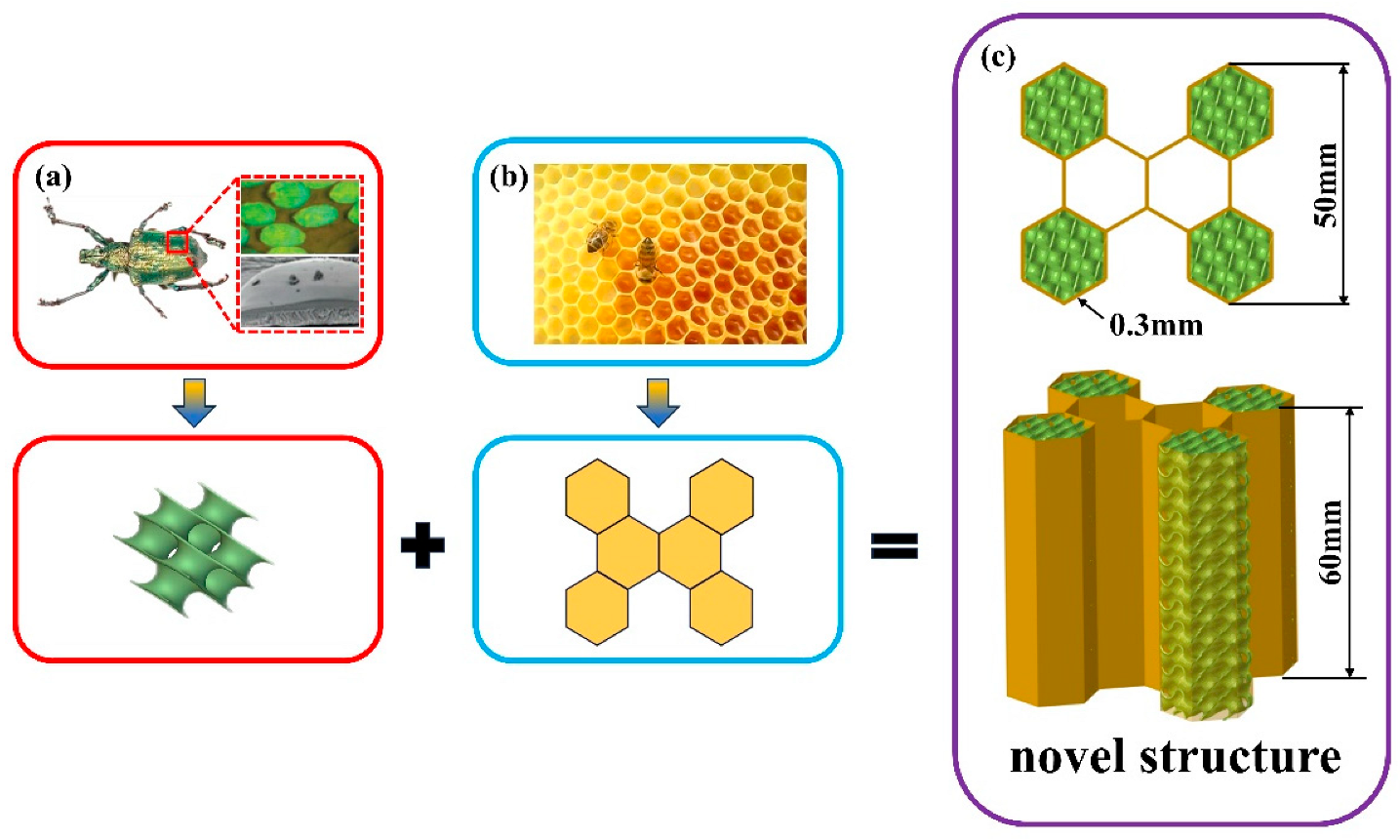
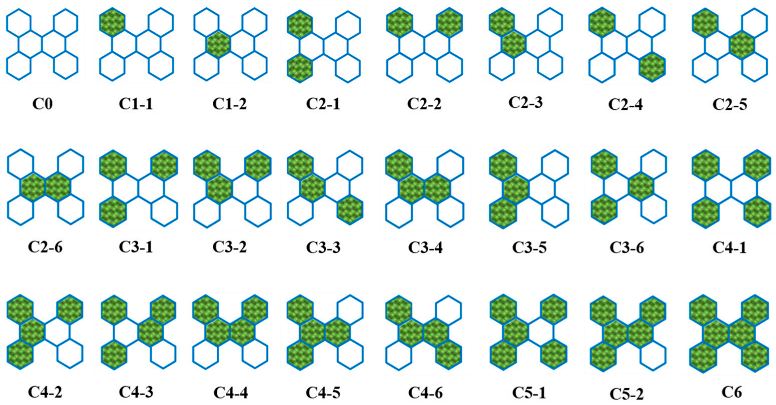
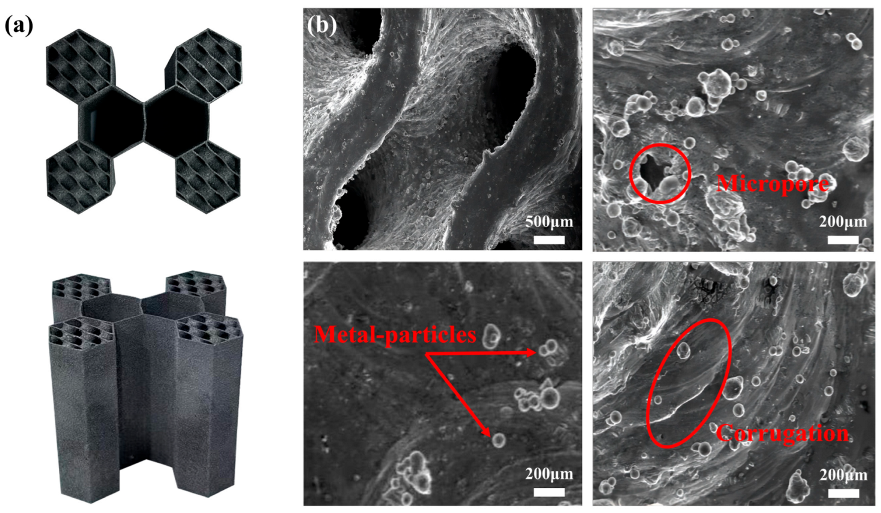
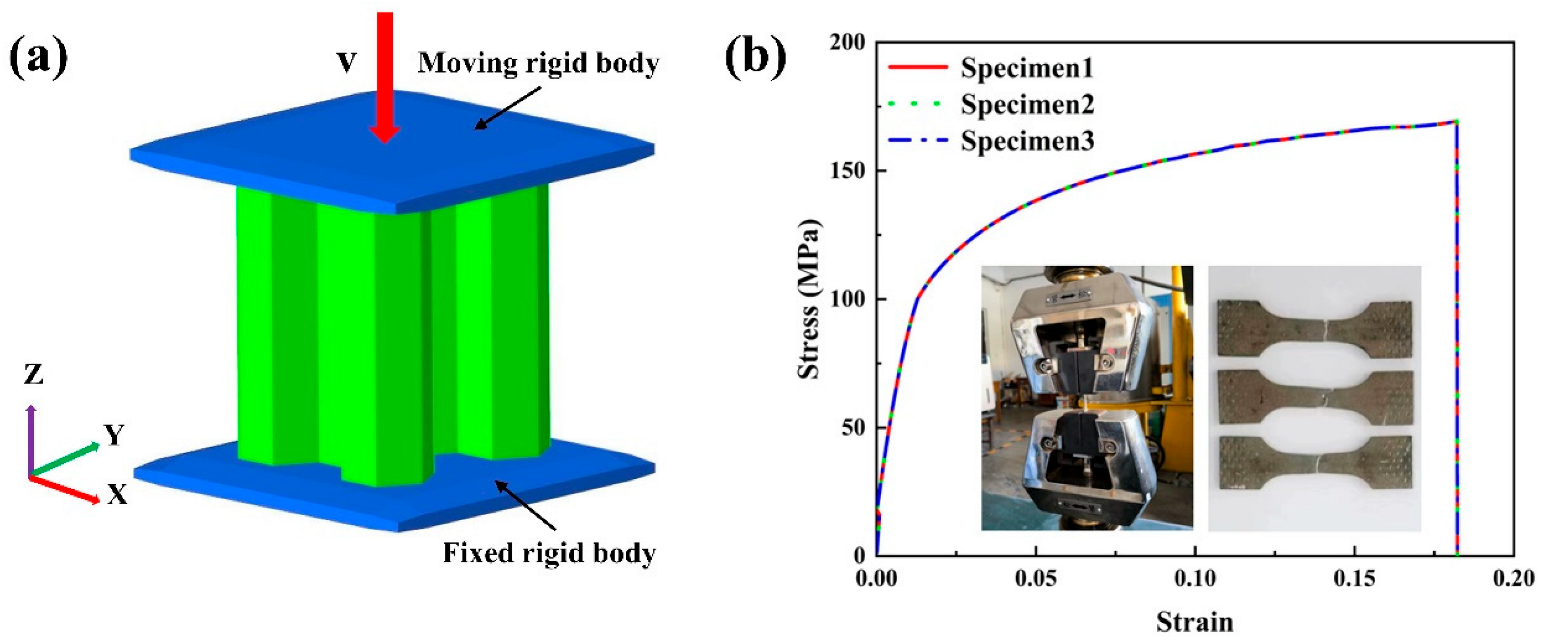
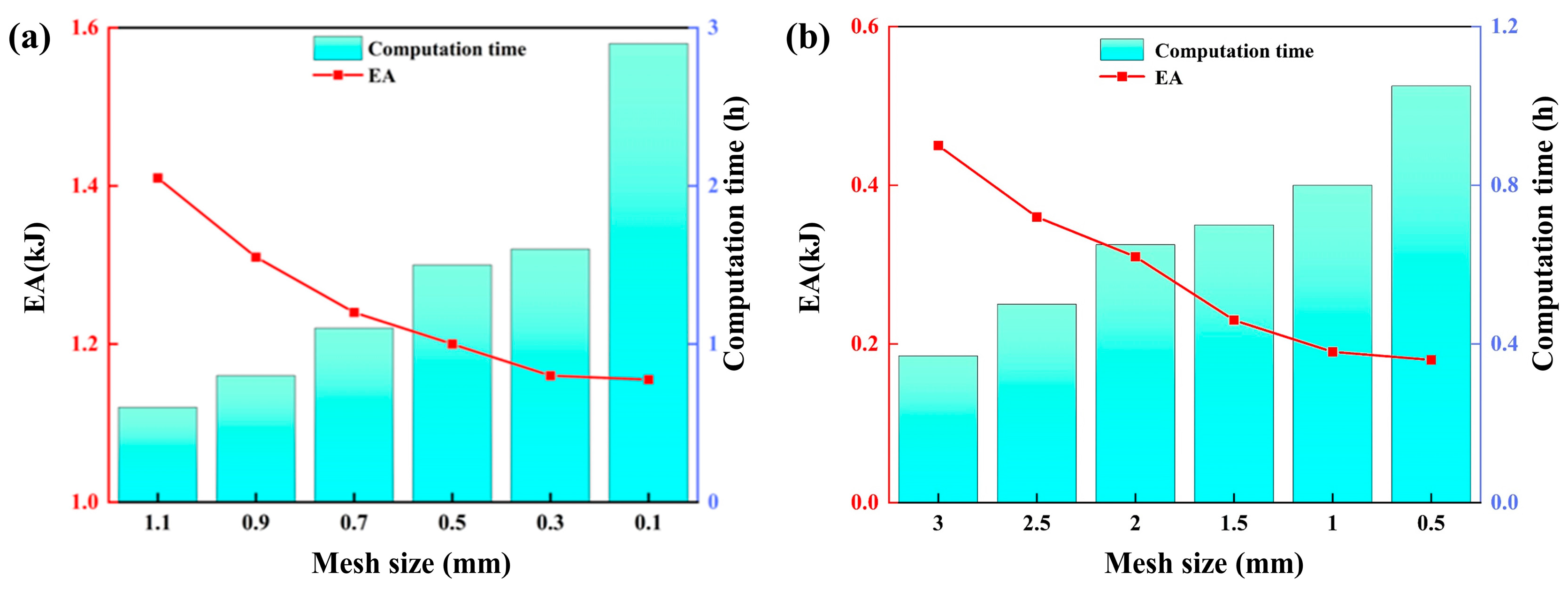
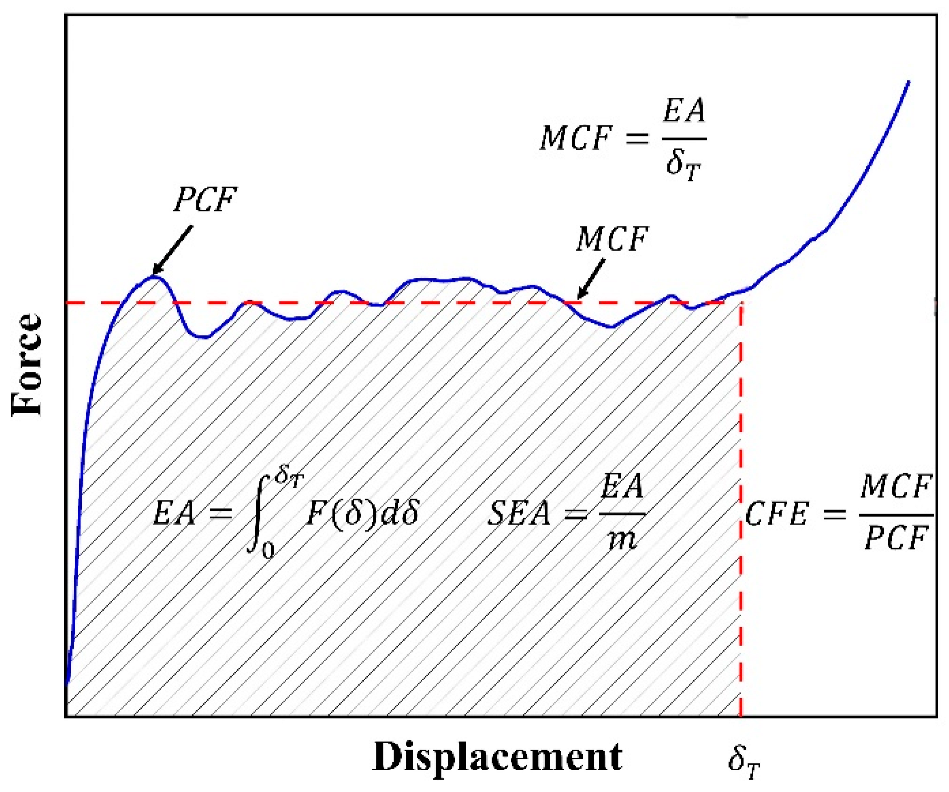

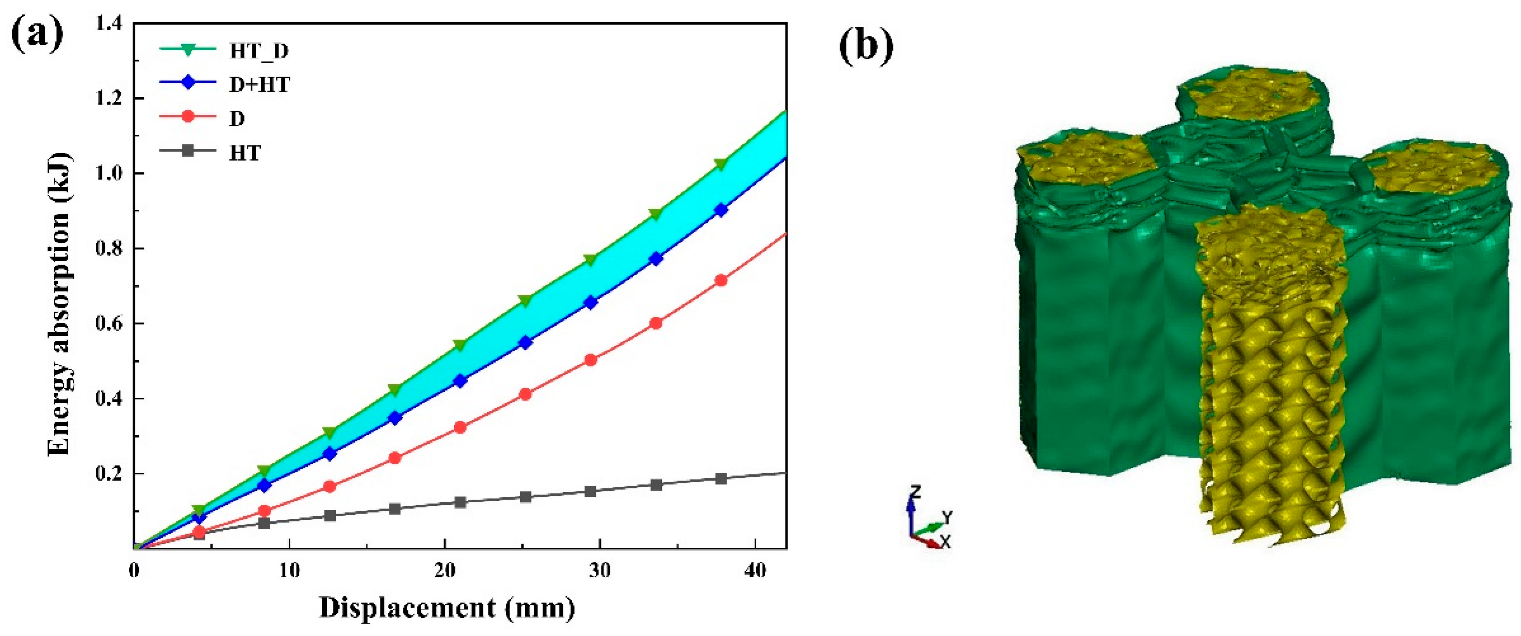
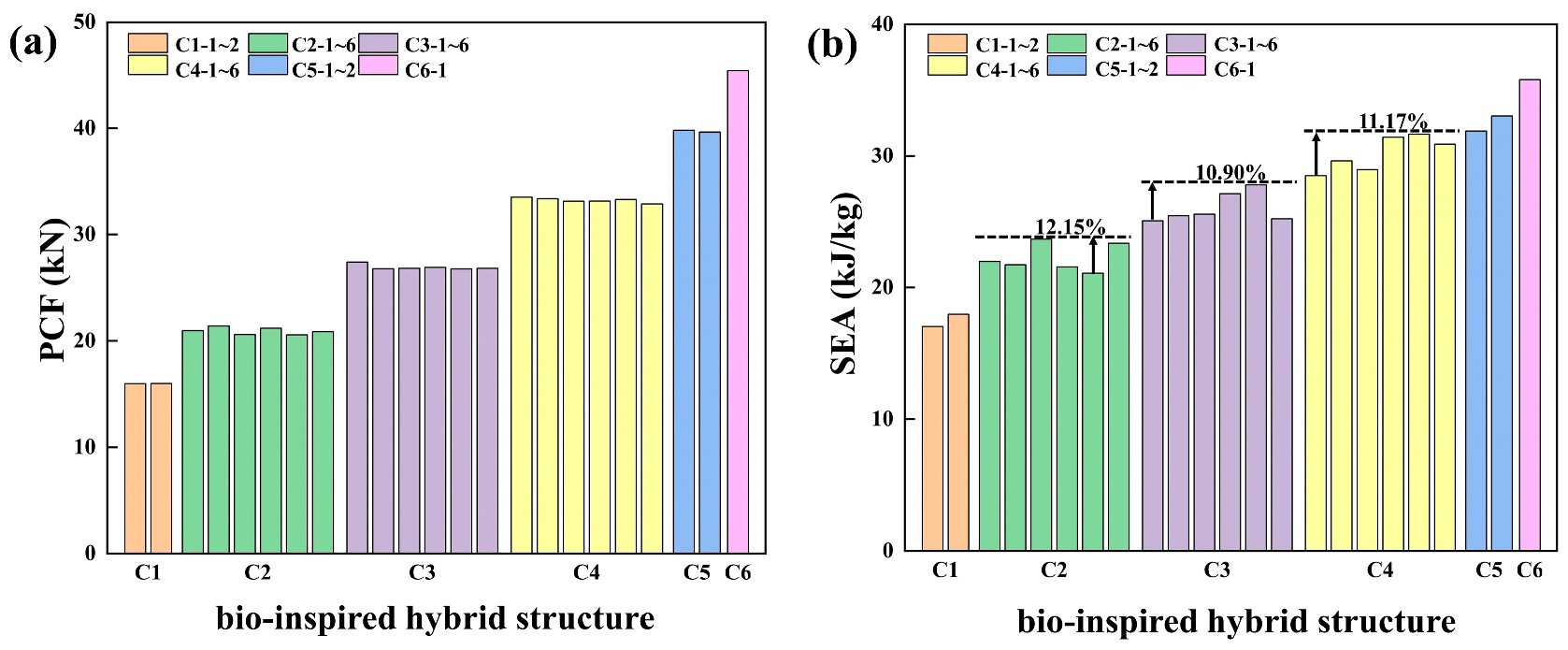
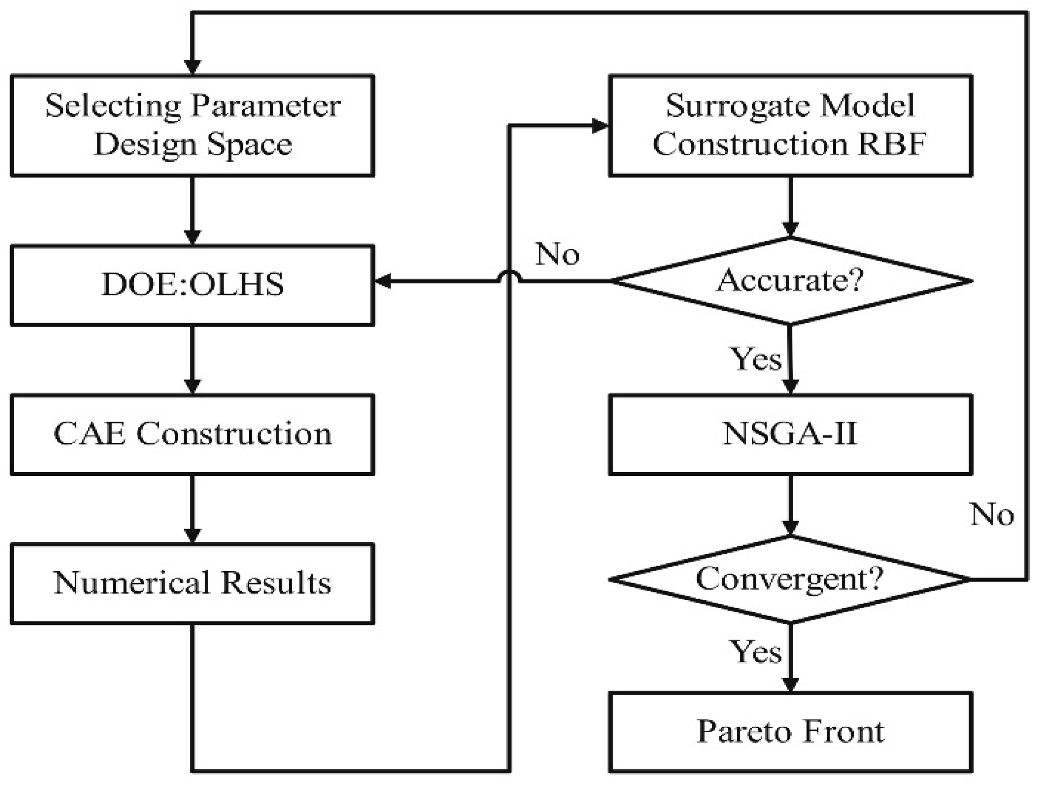

| Parameters | Laser Power (w) | Scanning Speed (mm/s) | Hatch Spacing (μm) | Layer Thickness (μm) |
|---|---|---|---|---|
| Values | 300 | 1100 | 140 | 30 |
| Material Name | Density | Poisson’s Ratio | Elastic Modulus | Yield Strength | Ultimate Strength | Ultimate Strain |
|---|---|---|---|---|---|---|
| AlSi10Mg | 2.68 g/cm3 | 0.33 | 25.4 GPa | 116 Mpa | 180 MPa | 0.17 |
| Types | EA (kJ) | SEA (kJ/kg) | PCF (kN) | MCF (kN) | CFE (%) |
|---|---|---|---|---|---|
| C0 | 0.196 | 8.968 | 13.859 | 4.867 | 35.117 |
| C1-1 | 0.455 | 17.045 | 15.977 | 11.316 | 70.826 |
| C1-2 | 0.480 | 17.981 | 15.992 | 11.437 | 71.517 |
| C2-1 | 0.695 | 21.993 | 20.975 | 17.273 | 82.350 |
| C2-2 | 0.687 | 21.732 | 21.403 | 17.734 | 82.859 |
| C2-3 | 0.748 | 23.662 | 20.600 | 18.584 | 90.216 |
| C2-4 | 0.682 | 21.574 | 21.190 | 16.197 | 76.436 |
| C2-5 | 0.667 | 21.099 | 20.574 | 16.571 | 80.543 |
| C2-6 | 0.738 | 23.346 | 20.869 | 18.336 | 87.861 |
| C3-1 | 0.914 | 25.059 | 27.419 | 22.719 | 82.858 |
| C3-2 | 0.929 | 25.461 | 26.795 | 23.084 | 86.152 |
| C3-3 | 0.933 | 25.576 | 26.843 | 23.187 | 86.382 |
| C3-4 | 0.990 | 27.143 | 26.921 | 24.357 | 90.475 |
| C3-5 | 1.014 | 27.791 | 26.779 | 25.196 | 94.088 |
| C3-6 | 0.919 | 25.196 | 26.833 | 22.175 | 82.641 |
| C4-1 | 1.178 | 28.479 | 33.526 | 29.272 | 87.312 |
| C4-2 | 1.224 | 29.590 | 33.382 | 30.414 | 91.108 |
| C4-3 | 1.198 | 28.950 | 33.145 | 29.756 | 89.775 |
| C4-4 | 1.300 | 31.430 | 33.164 | 31.304 | 94.392 |
| C4-5 | 1.310 | 31.661 | 33.311 | 31.542 | 94.689 |
| C4-6 | 1.278 | 30.896 | 32.887 | 31.756 | 96.562 |
| C5-1 | 1.474 | 31.876 | 39.807 | 36.617 | 91.986 |
| C5-2 | 1.527 | 33.022 | 39.629 | 37.946 | 95.753 |
| C6 | 1.831 | 35.808 | 45.417 | 44.253 | 97.436 |
| Model | Error Type | Objectives | |
|---|---|---|---|
| SEA | PCF | ||
| C4-1 | R2 | 0.961 | 0.952 |
| RMSE | 0.086 | 0.063 | |
| Sample Point | Parameters | SEA (kJ/kg) | PCF (kN) | |||||
|---|---|---|---|---|---|---|---|---|
| t (mm) | RBF | FE | Error (%) | RBF | FE | Error (%) | ||
| A | 0.194 | 0.235 | 28.479 | 29.778 | 4.56 | 33.526 | 34.958 | 4.27 |
| B | 0.273 | 0.431 | 33.031 | 31.921 | −3.36 | 49.574 | 51.537 | 3.96 |
| C | 0.413 | 0.763 | 37.631 | 39.464 | 4.87 | 80.669 | 83.21 | 3.15 |
Disclaimer/Publisher’s Note: The statements, opinions and data contained in all publications are solely those of the individual author(s) and contributor(s) and not of MDPI and/or the editor(s). MDPI and/or the editor(s) disclaim responsibility for any injury to people or property resulting from any ideas, methods, instructions or products referred to in the content. |
© 2024 by the authors. Licensee MDPI, Basel, Switzerland. This article is an open access article distributed under the terms and conditions of the Creative Commons Attribution (CC BY) license (https://creativecommons.org/licenses/by/4.0/).
Share and Cite
Song, J.; Huo, Q.; Li, D.; Chen, B.; Zhang, J. Energy-Absorption Behavior of Novel Bio-Inspired Thin-Walled Honeycomb Tubes Filled with TPMS Structure. Coatings 2024, 14, 675. https://doi.org/10.3390/coatings14060675
Song J, Huo Q, Li D, Chen B, Zhang J. Energy-Absorption Behavior of Novel Bio-Inspired Thin-Walled Honeycomb Tubes Filled with TPMS Structure. Coatings. 2024; 14(6):675. https://doi.org/10.3390/coatings14060675
Chicago/Turabian StyleSong, Jian, Qidong Huo, Dongming Li, Bingzhi Chen, and Jun Zhang. 2024. "Energy-Absorption Behavior of Novel Bio-Inspired Thin-Walled Honeycomb Tubes Filled with TPMS Structure" Coatings 14, no. 6: 675. https://doi.org/10.3390/coatings14060675
APA StyleSong, J., Huo, Q., Li, D., Chen, B., & Zhang, J. (2024). Energy-Absorption Behavior of Novel Bio-Inspired Thin-Walled Honeycomb Tubes Filled with TPMS Structure. Coatings, 14(6), 675. https://doi.org/10.3390/coatings14060675






